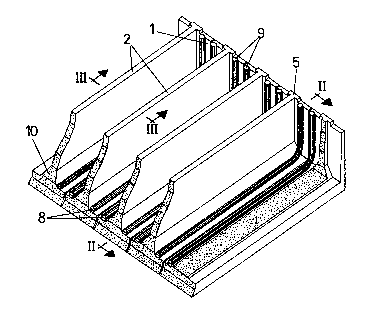Some of the information on this Web page has been provided by external sources. The Government of Canada is not responsible for the accuracy, reliability or currency of the information supplied by external sources. Users wishing to rely upon this information should consult directly with the source of the information. Content provided by external sources is not subject to official languages, privacy and accessibility requirements.
Any discrepancies in the text and image of the Claims and Abstract are due to differing posting times. Text of the Claims and Abstract are posted:
| (12) Patent: | (11) CA 2116205 |
|---|---|
| (54) English Title: | CLEANING SYSTEM FOR ELECTROLYTIC TANKS |
| (54) French Title: | SYSTEME DE NETTOYAGE POUR RESERVOIRS D'ELECTROLYTES |
| Status: | Term Expired - Post Grant Beyond Limit |
| (51) International Patent Classification (IPC): |
|
|---|---|
| (72) Inventors : |
|
| (73) Owners : |
|
| (71) Applicants : |
|
| (74) Agent: | MARKS & CLERK |
| (74) Associate agent: | |
| (45) Issued: | 1999-02-23 |
| (22) Filed Date: | 1994-02-22 |
| (41) Open to Public Inspection: | 1995-02-11 |
| Examination requested: | 1996-10-31 |
| Availability of licence: | N/A |
| Dedicated to the Public: | N/A |
| (25) Language of filing: | English |
| Patent Cooperation Treaty (PCT): | No |
|---|
| (30) Application Priority Data: | ||||||
|---|---|---|---|---|---|---|
|
A cleaning system for electrolytic tanks consisting
of a cell with a preferably rectangular layout, very long
relative to its width, and which is provided with at
least one conduit with perforated walls, and preferably
two, which run over the bottom of the cell, along its
length, and ascend alongside the shorter walls until they
reach, approximately, the level of liquid of the tank,
said cell being provided below with surfaces which are
inclined towards the perforated conduits, said conduits
having sufficient cross-sectional area to act as guides
through which are inserted a suction head and pipe for
sludge extraction.
Cette invention concerne un système de nettoyage pour cuves électrolytiques se présentant sous la forme d'une cellule de préférence rectangulaire considérablement plus longue que large, qui comporte au moins un et, de préférence, deux conduits à parois perforées qui sont établies sur le fond dans le sens de la longueur et remontent le long des parois d'extrémité environ jusqu'au niveau du liquide dans ladite cellule qui comporte, sous ce niveau, des surfaces inclinées vers les conduits perforés, lesdits conduits ayant une section transversale suffisante pour qu'on puisse y loger une tête et un tuyau d'aspiration servant à l'extraction des boues.
Note: Claims are shown in the official language in which they were submitted.
Note: Descriptions are shown in the official language in which they were submitted.

2024-08-01:As part of the Next Generation Patents (NGP) transition, the Canadian Patents Database (CPD) now contains a more detailed Event History, which replicates the Event Log of our new back-office solution.
Please note that "Inactive:" events refers to events no longer in use in our new back-office solution.
For a clearer understanding of the status of the application/patent presented on this page, the site Disclaimer , as well as the definitions for Patent , Event History , Maintenance Fee and Payment History should be consulted.
| Description | Date |
|---|---|
| Inactive: Expired (new Act pat) | 2014-02-22 |
| Inactive: IPC from MCD | 2006-03-11 |
| Grant by Issuance | 1999-02-23 |
| Inactive: Correspondence - Formalities | 1999-02-09 |
| Inactive: Final fee received | 1998-11-09 |
| Pre-grant | 1998-11-09 |
| Notice of Allowance is Issued | 1998-09-08 |
| Notice of Allowance is Issued | 1998-09-08 |
| Letter Sent | 1998-09-08 |
| Inactive: Application prosecuted on TS as of Log entry date | 1998-08-31 |
| Inactive: Status info is complete as of Log entry date | 1998-08-31 |
| Inactive: IPC assigned | 1998-08-11 |
| Inactive: Approved for allowance (AFA) | 1998-08-06 |
| All Requirements for Examination Determined Compliant | 1996-10-31 |
| Request for Examination Requirements Determined Compliant | 1996-10-31 |
| Application Published (Open to Public Inspection) | 1995-02-11 |
There is no abandonment history.
The last payment was received on 1998-12-23
Note : If the full payment has not been received on or before the date indicated, a further fee may be required which may be one of the following
Please refer to the CIPO Patent Fees web page to see all current fee amounts.
Note: Records showing the ownership history in alphabetical order.
| Current Owners on Record |
|---|
| ASTURIANA DE ZINC, S.A. |
| Past Owners on Record |
|---|
| FERNANDO SITGES MENENDEZ |
| FRANCISCO ALVAREZ TAMARGO |
| FRANCISCO JAVIER SITGES MENENDEZ |
| IVES LEFEVRE |